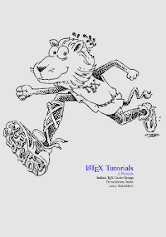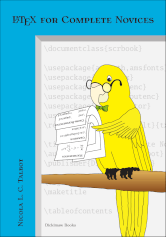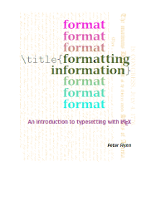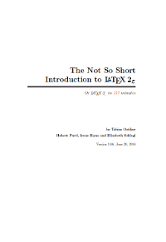Last Updated on August 17, 2024
LaTeX is a professional document preparation system and document markup language written by Leslie Lamport. It’s a very mature system with development starting more than 30 years ago.
LaTeX is widely used in the publication of scientific documents in many disciplines, such as mathematics, statistics, physics, economics, political science. It helps an author produce professional looking documents, papers, and books that are perfectly typeset. The formatted works are consistent, accurate, and reusable. It’s particularly suited to the production of long articles and books, as it has facilities for the automatic numbering of chapters, sections, theorems, equations etc., and also has facilities for cross-referencing. LaTeX is not a WYSIWYG system.
LaTeX uses the TeX typesetting program for formatting its output. LaTeX is a set of macros for TeX that aims to help the user concentrate on the content, rather than the formatting.
Here’s our recommended LaTeX books. Most of the books are published under an open source license, and all of them are free to read.
1. LaTeX Tutorials: A Primer by Indian TeX Users Group by Indian TeX Users Group

Packed with fully explained examples, LaTeX Tutorials: A Primer is a hands-on introduction quickly leading a novice user to professional-quality results. It’s published by the Indian TeX Users Group.
If you are about to write mathematical or scientific papers, seminar handouts, or even plan to write a thesis, this book offers you a fast-paced and practical introduction. Particularly during studying in school and university you’ll benefit enormously, as a mathematician or physicist as well as an engineer or a humanist.
Contents of the book
- The Basics – what is LaTeX, simple typesetting, fonts.
- The Document – describes how an entire document with chapters and sections can be produced.
- Bibliography – the BibTeX program is examined.
- Bibliographic Databases – the reader is shown how to create a bibliographic database.
- Table of contents, Index and Glossary.
- Displayed Text – shows the reader various constructs for displaying text depending on the nature of the displayed text.
- Rows and Columns – keeping tabs, and tables are examined.
- Typesetting Mathematics – including custom commands, new operators, and symbols.
- Typesetting Theorems – using the declaration \newtheorem.
- Several Kinds of Boxes – LR boxes, Par, Rule.
- Floats – a good tutorial on the thorny problem of figures.
- Cross References in LATEX.
- Footnotes, Marginpars, and Endnotes.
This book is released under the GNU Free Documentation License, version 1.2.
2. LaTeX for Complete Novices by Nicola L. C. Talbot

LaTeX for Complete Novices aims to introduce LaTeX to a non-technical person.
The contents of the book include:
- Definitions – source code, output file, DVI file, auxiliary files, commands, grouping, arguments, declarations, and more.
- TeXWorks.
- Creating a Simple Document – looks at packages, special characters and symbols, lists, and more.
- Structuring Your Document – author and title information, abstract, chapters, sections, subsections, create a table of contents, cross-referencing, create a bibliography, page styles and page numbering, and multi-lingual support using the babel package.
- The graphicx Package.
- Floats – figures, tables, sideways floats, and sub-floats.
- Defining Commands.
- Mathematica – in-line mathematics, displayed mathematics, multiple lines of displayed maths, and mathematical commands.
- Defining Environments.
- Counters.
- Common Errors.
This book is distributed under the GNU Free Documentation License, Version 1.2.
3. Formatting Information – An Introduction to typesetting with LaTeX by Peter Flynn

Formatting Information is an introduction to typesetting with LaTeX designed for those with no previous experience. This is the seventh edition.
This book originally accompanied a two-day course on using the LaTeX typesetting system. It was extensively revised and updated for publication, so that it could be used for self-study as well as in the classroom.
This book provides a wealth of information on:
- Writing documents – markup, choosing your LaTeX processor, quick start, LaTeX commands, white-space in LaTeX, special characters, quotation marks, accents, and more.
- Basic structures – looks at the document class declaration, the document environment, titling, abstracts and summaries, and more.
- CTAN and packages – packages and classes, installing classes and packages.
- Lists, tables, figures – also covers images, quotations, boxes, sidebars, panels, and verbatim text.
- Textual tools – footnotes and end-notes, marginal notes, references, indexes and glossaries, and multiple columns.
- Layouts and fonts – changing layout, using fonts, and the LaTeX font catalogue.
- Programmability – simple replacement macros, macros using information gathered previously, macros with arguments, nested macros, macros and environments, and reprogrammable LaTeX’s internals.
- Compatibility – converting into LaTeX, converting out of LaTeX, and going beyond LaTeX.
The book is distributed under a ‘copyleft’ license.
4. The Not So Short Introduction to LATEX 2e by Tobias Oetiker

LaTeX is a system for writing documents with perfect looks while the author fully concentrates on the content. This document shows you how to do this. It is arguably the best book to fully learn how to use LaTeX, although I would not recommend it for a beginner, as it includes just about anything you want to know about the system. If you are new to LaTeX, check some of the later introductory books.
The contents of the book:
- Explains the basic structure of LaTeX to give the reader a general understanding.
- Explains the details of typesetting text, covering the majority of the essential LaTeX commands and environments.
- Learn how to typeset mathematical formulae with LaTeX laden with examples.
- Indexes, bibliography generation and EPS graphics. It also introduces creation of PDF documents with pdfLaTeX and looks at some extension packages.
- How to use LaTeX for creating graphics.
- Details some potentially dangerous information about how to change the standard document layout produced by LaTeX.
This book is distributed under the GNU General Public License version 2 or later.
Next page: Page 2 – Let’s Learn LaTeX and more books
Pages in this article:
Page 1 – LaTeX Tutorials: A Primer and more books
Page 2 – Let’s Learn LaTeX and more books
Page 3 – Using LaTeX to Write a PhD Thesis and more books
Page 4 – The Computer Science of TeX and LaTeX and more books
All books in this series:
| Free Programming Books | |
|---|---|
| Ada | ALGOL-like programming language, extended from Pascal and other languages |
| Agda | Dependently typed functional language based on intuitionistic Type Theory |
| Arduino | Inexpensive, flexible, open source microcontroller platform |
| Assembly | As close to writing machine code without writing in pure hexadecimal |
| Awk | Versatile language designed for pattern scanning and processing language |
| Bash | Shell and command language; popular both as a shell and a scripting language |
| BASIC | Beginner’s All-purpose Symbolic Instruction Code |
| C | General-purpose, procedural, portable, high-level language |
| C++ | General-purpose, portable, free-form, multi-paradigm language |
| C# | Combines the power and flexibility of C++ with the simplicity of Visual Basic |
| Clojure | Dialect of the Lisp programming language |
| ClojureScript | Compiler for Clojure that targets JavaScript |
| COBOL | Common Business-Oriented Language |
| CoffeeScript | Transcompiles into JavaScript inspired by Ruby, Python and Haskell |
| Coq | Dependently typed language similar to Agda, Idris, F* and others |
| Crystal | General-purpose, concurrent, multi-paradigm, object-oriented language |
| CSS | CSS (Cascading Style Sheets) specifies a web page’s appearance |
| D | General-purpose systems programming language with a C-like syntax |
| Dart | Client-optimized language for fast apps on multiple platforms |
| Dylan | Multi-paradigm language supporting functional and object-oriented coding |
| ECMAScript | Best known as the language embedded in web browsers |
| Eiffel | Object-oriented language designed by Bertrand Meyer |
| Elixir | Relatively new functional language running on the Erlang virtual machine |
| Erlang | General-purpose, concurrent, declarative, functional language |
| F# | Uses functional, imperative, and object-oriented programming methods |
| Factor | Dynamic stack-based programming language |
| Forth | Imperative stack-based programming language |
| Fortran | The first high-level language, using the first compiler |
| Go | Compiled, statically typed programming language |
| Groovy | Powerful, optionally typed and dynamic language |
| Haskell | Standardized, general-purpose, polymorphically, statically typed language |
| HTML | HyperText Markup Language |
| Icon | Wide variety of features for processing and presenting symbolic data |
| J | Array programming language based primarily on APL |
| Java | General-purpose, concurrent, class-based, object-oriented, high-level language |
| JavaScript | Interpreted, prototype-based, scripting language |
| Julia | High-level, high-performance language for technical computing |
| Kotlin | More modern version of Java |
| LabVIEW | Designed to enable domain experts to build power systems quickly |
| LaTeX | Professional document preparation system and document markup language |
| Lisp | Unique features - excellent to study programming constructs |
| Logo | Dialect of Lisp that features interactivity, modularity, extensibility |
| Lua | Designed as an embeddable scripting language |
| Markdown | Plain text formatting syntax designed to be easy-to-read and easy-to-write |
| Objective-C | Object-oriented language that adds Smalltalk-style messaging to C |
| OCaml | The main implementation of the Caml language |
| Pascal | Imperative and procedural language designed in the late 1960s |
| Perl | High-level, general-purpose, interpreted, scripting, dynamic language |
| PHP | PHP has been at the helm of the web for many years |
| PostScript | Interpreted, stack-based and Turing complete language |
| Prolog | A general purpose, declarative, logic programming language |
| PureScript | Small strongly, statically typed language compiling to JavaScript |
| Python | General-purpose, structured, powerful language |
| QML | Hierarchical declarative language for user interface layout - JSON-like syntax |
| R | De facto standard among statisticians and data analysts |
| Racket | General-purpose, object-oriented, multi-paradigm, functional language |
| Raku | Member of the Perl family of programming languages |
| Ruby | General purpose, scripting, structured, flexible, fully object-oriented language |
| Rust | Ideal for systems, embedded, and other performance critical code |
| Scala | Modern, object-functional, multi-paradigm, Java-based language |
| Scheme | A general-purpose, functional language descended from Lisp and Algol |
| Scratch | Visual programming language designed for 8-16 year-old children |
| SQL | Access and manipulate data held in a relational database management system |
| Standard ML | General-purpose functional language characterized as "Lisp with types" |
| Swift | Powerful and intuitive general-purpose programming language |
| Tcl | Dynamic language based on concepts of Lisp, C, and Unix shells |
| TeX | Markup and programming language - create professional quality typeset text |
| TypeScript | Strict syntactical superset of JavaScript adding optional static typing |
| Vala | Object-oriented language, syntactically similar to C# |
| VHDL | Hardware description language used in electronic design automation |
| VimL | Powerful scripting language of the Vim editor |
| XML | Rules for defining semantic tags describing structure ad meaning |
